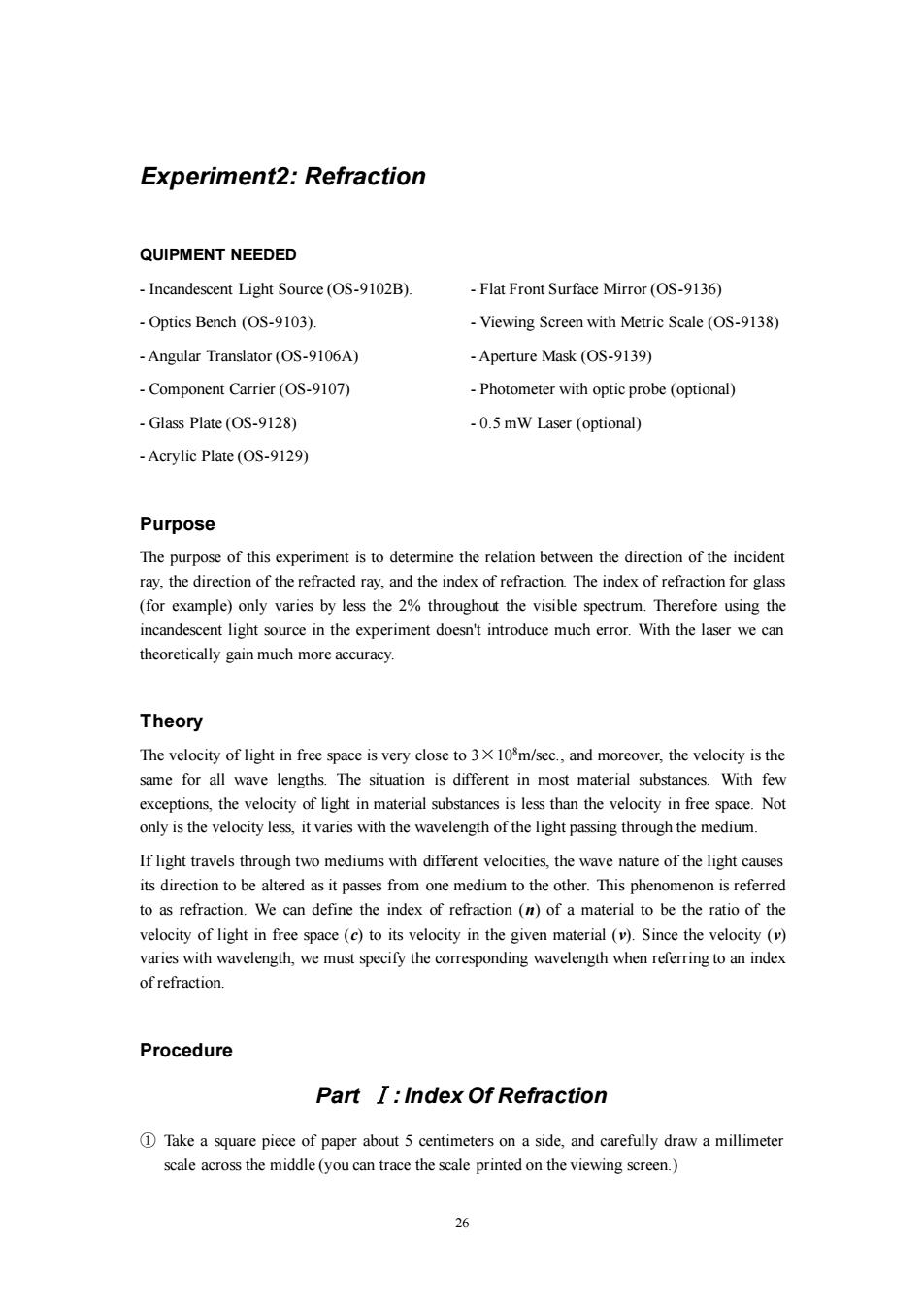正在加载图片...

Experiment2:Refraction QUIPMENT NEEDED Incandescent Light Source(OS-9102B). Flat Front Surface Mirror(OS-9136) Optics Bench (OS-9103). Viewing Screen with Metric Scale(OS-9138) -Angular Translator(OS-9106A) -Aperture Mask(OS-9139) -Component Carrier(OS-9107) -Photometer with optic probe (optional) Glass Plate(OS-9128) -0.5 mW Laser (optional) -Acrylic Plate(OS-9129) Purpose The purpose of this experiment is to determine the relation between the direction of the incident ray,the direction of the refracted ray,and the index of refraction.The index of refraction for glass (for example)only varies by less the 2%throughout the visible spectrum.Therefore using the incandescent light source in the experiment doesn't introduce much error.With the laser we can theoretically gain much more accuracy. Theory The velocity of light in free space is very close to 3X 108m/sec.,and moreover,the velocity is the same for all wave lengths.The situation is different in most material substances.With few exceptions,the velocity of light in material substances is less than the velocity in free space.Not only is the velocity less,it varies with the wavelength of the light passing through the medium. If light travels through two mediums with different velocities,the wave nature of the light causes its direction to be altered as it passes from one medium to the other.This phenomenon is referred to as refraction.We can define the index of refraction (n)of a material to be the ratio of the velocity of light in free space(c)to its velocity in the given material (v).Since the velocity (v) varies with wavelength,we must specify the corresponding wavelength when referring to an index of refraction. Procedure Part I:Index Of Refraction 1 Take a square piece of paper about 5 centimeters on a side,and carefully draw a millimeter scale across the middle(you can trace the scale printed on the viewing screen.) 23626 Experiment2: Refraction QUIPMENT NEEDED - Incandescent Light Source (OS-9102B). - Optics Bench (OS-9103). - Angular Translator (OS-9106A) - Component Carrier (OS-9107) - Glass Plate (OS-9128) - Acrylic Plate (OS-9129) - Flat Front Surface Mirror (OS-9136) - Viewing Screen with Metric Scale (OS-9138) - Aperture Mask (OS-9139) - Photometer with optic probe (optional) - 0.5 mW Laser (optional) Purpose The purpose of this experiment is to determine the relation between the direction of the incident ray, the direction of the refracted ray, and the index of refraction. The index of refraction for glass (for example) only varies by less the 2% throughout the visible spectrum. Therefore using the incandescent light source in the experiment doesn't introduce much error. With the laser we can theoretically gain much more accuracy. Theory The velocity of light in free space is very close to 3×108m/sec., and moreover, the velocity is the same for all wave lengths. The situation is different in most material substances. With few exceptions, the velocity of light in material substances is less than the velocity in free space. Not only is the velocity less, it varies with the wavelength of the light passing through the medium. If light travels through two mediums with different velocities, the wave nature of the light causes its direction to be altered as it passes from one medium to the other. This phenomenon is referred to as refraction. We can define the index of refraction (n) of a material to be the ratio of the velocity of light in free space (c) to its velocity in the given material (v). Since the velocity (v) varies with wavelength, we must specify the corresponding wavelength when referring to an index of refraction. Procedure Part Ⅰ: Index Of Refraction ① Take a square piece of paper about 5 centimeters on a side, and carefully draw a millimeter scale across the middle (you can trace the scale printed on the viewing screen.)